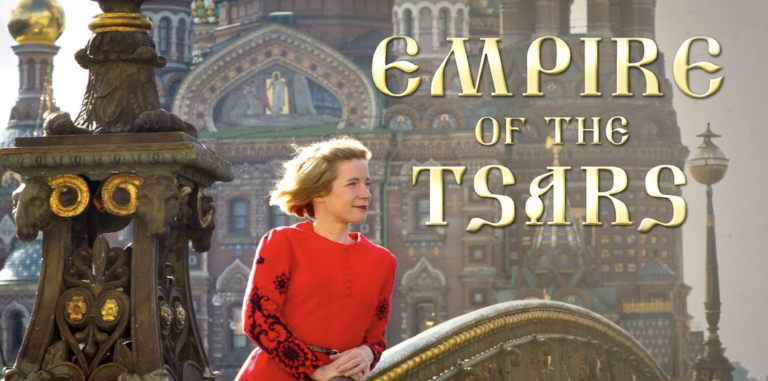Empire of the Tsars – Romanov Russia episode 1 – Reinventing Russia: Lucy Worsley travels to Russia to tell the extraordinary story of the dynasty that ruled the country for more than three centuries. It’s an epic tale that includes giant figures such as Peter the Great and Catherine the Great, the devastating struggle against Napoleon in 1812, and the political murders of Nicholas II and his family in 1918 which brought the dynasty to a brutal end.
In this first episode of Empire of the Tsars, Lucy investigates the beginning of the Romanovs’ 300-year reign in Russia. In 1613, when Russia was leaderless, 16-year-old Mikhail Romanov was plucked from obscurity and offered the crown of Russia. Mikhail was granted absolute power and began the reign of the Romanovs as the most influential dynasty in modern European history.
Lucy also charts the story of Peter the Great, the ruthless and ambitious tsar who was determined to modernise Russia at the end of the 17th century. Lucy traces Peter’s accession to the throne as a nine-year-old, when he witnessed a revolt led by royal guards and the slaughter of his uncles and close advisors. Sixteen years later, Peter would vengefully execute a thousand rebellious guards. Throughout his reign, Peter would demonstrate an unwavering commitment to establishing Russia as a naval power – Lucy explores the lengths to which Peter would go to ensure this became a reality, including the creation of a new maritime capital, St Petersburg.
Lucy shows how the Romanovs embraced and sponsored the arts on an astonishing scale – from building spectacular palaces to commissioning grand artworks – that all still dazzle today. As well as studying this unique royal family, Lucy also considers the impact the Romanovs had on the lives of ordinary Russians, who were often little better than slaves to the elite.
Empire of the Tsars – Romanov Russia episode 1 – Reinventing Russia
Russia
Russia is a transcontinental country spanning Eastern Europe and Northern Asia. It extends from the Baltic Sea in the west to the Pacific Ocean in the east, and from the Arctic Ocean in the north to the Black and Caspian seas in the south. Russia covers over 17,125,191 square kilometres (6,612,073 sq mi), stretching more than one-eighth of the Earth’s inhabited land area, with eleven time zones, and borders with 16 sovereign nations. Moscow is the country’s capital and largest city; and Saint Petersburg is the second-largest city.
Russia is the largest country in the world, the ninth-most populous country, as well as the most populous country in Europe. The country is one of the world’s most sparsely populated and urbanised. About half of the country’s total area is forested, concentrating around four-fifths of its total population of over 146.8 million on its smaller and dense western portion, as opposed to its larger and sparse eastern portion. Russia is administratively divided into 85 federal subjects. The Moscow Metropolitan Area is the largest metropolitan area in Europe, and among the largest in the world, with more than 20 million residents.
House of Romanov – Empire of the Tsars
The House of Romanov was the reigning imperial house of Russia from 1613 to 1917. The Romanovs achieved prominence as boyars of the Grand Duchy of Moscow and later of the Tsardom of Russia under the reigning Rurik dynasty, which became extinct upon the death of Tsar Feodor I in 1598. The Time of Troubles, caused by the resulting succession crisis, saw several pretenders and imposters (False Dmitris) fight for the crown during the Polish–Muscovite War of 1605-1618. On 21 February 1613, a Zemsky Sobor elected Michael Romanov as Tsar of Russia, establishing the Romanovs as Russia’s second reigning dynasty. Michael’s grandson Peter I, who established the Russian Empire in 1721, transformed the country into a great power through a series of wars and reforms.
The direct male line of the Romanovs ended when Empress Elizabeth of Russia died in 1762, thus the House of Holstein-Gottorp (a cadet branch of the German House of Oldenburg that reigned in Denmark) ascended to the throne in the person of Peter III. Officially known as members of the House of Romanov, descendants after Elizabeth are sometimes referred to as “Holstein-Gottorp-Romanov”. The abdication of Emperor Nicholas II on 15 March 1917 as a result of the February Revolution ended 304 years of Romanov rule and led to the establishing of the Russian Republic under the Russian Provisional Government in the lead-up to the Russian Civil War of 1917-1922. In 1918 Bolshevik officials executed the ex-Emperor and his family. Of the House of Romanov’s 65 members, 47 survivors went into exile abroad.





Pingback: Empire of the Tsars - Romanov Russia episode 2 - Age of Extremes